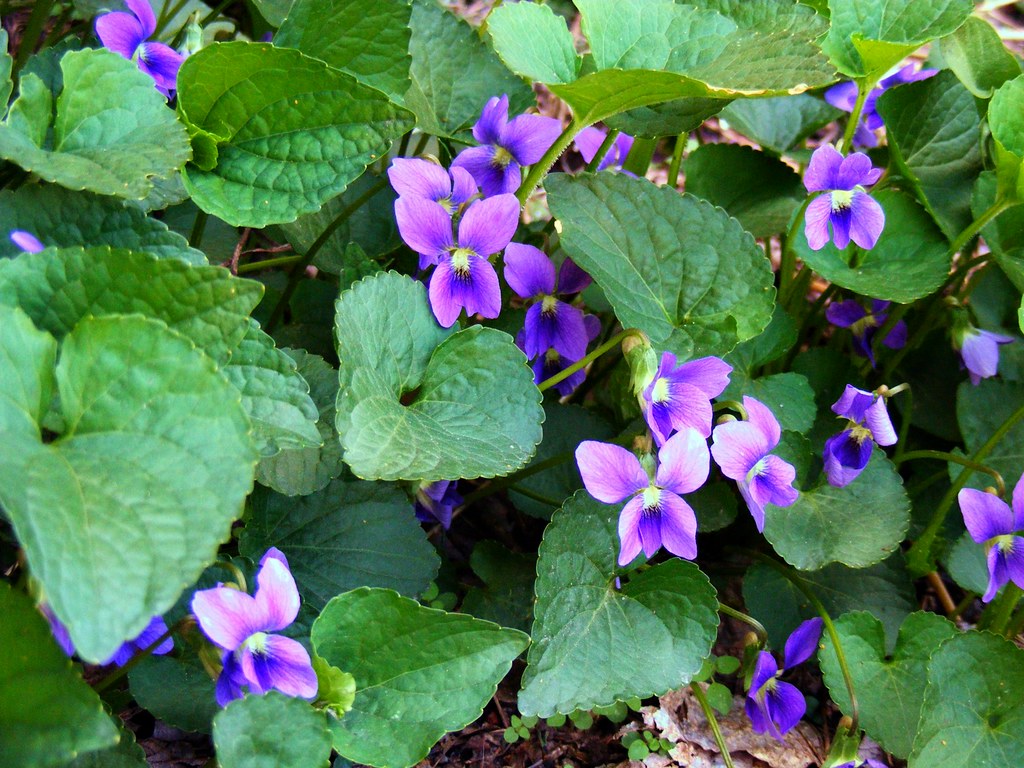 Indeed! Since my childhood I've loved the spring wood violets and I still do, but with a sometimes less favorable eye than when I was younger. This somewhat endemic species, Viola sororia, as most midwesterners know, can be an outright rogue in the lawn and gardens, where it multiplies so quickly that it can threaten overtaking some of our more desirable perennials in the border. But honestly, isn't it hard to resist any of the Viola species? At least it is for me ... so we've come to a basically tolerant compromise with the hundreds of Violets that spread through our gardening areas and lawn. We can't eliminate them, they're so pretty we feel guilty about digging them and sending them to the compost, but where they intrude too far, we have no compunction about discarding them ... it's not like we'll ever go lacking in spring violets! And I should say that when we go at them in one area and dig up a lot of them, we usually take them to the back yard and plant them around the base of the old maple out there ... not all of them make it, due to the heavy dog traffic, but we're appreciative of those who do. After all, no matter how much of a pest they can become, they are a native species that deserves some respect!
Indeed! Since my childhood I've loved the spring wood violets and I still do, but with a sometimes less favorable eye than when I was younger. This somewhat endemic species, Viola sororia, as most midwesterners know, can be an outright rogue in the lawn and gardens, where it multiplies so quickly that it can threaten overtaking some of our more desirable perennials in the border. But honestly, isn't it hard to resist any of the Viola species? At least it is for me ... so we've come to a basically tolerant compromise with the hundreds of Violets that spread through our gardening areas and lawn. We can't eliminate them, they're so pretty we feel guilty about digging them and sending them to the compost, but where they intrude too far, we have no compunction about discarding them ... it's not like we'll ever go lacking in spring violets! And I should say that when we go at them in one area and dig up a lot of them, we usually take them to the back yard and plant them around the base of the old maple out there ... not all of them make it, due to the heavy dog traffic, but we're appreciative of those who do. After all, no matter how much of a pest they can become, they are a native species that deserves some respect! As I was writing this post, I thought about where you find them in urban areas ... and I came to a not entirely empirical conclusion that one finds them mostly in older, established areas these days, and not so very much in the newly developed sub-divisions ... to my mind that's a sad observation. I've never been much a fan of the seemingly inevitable, overly developed suburban building, and it just confirms why I feel so much more comfortable in an old house in an older part of the city. Yes, we have our common weedy herbaceous species in abundance ("Creeping Charlie" aka "Ground Ivy," purple and white clover, garden nightshade vine --you know, the kind of vine that produces red berries your mother always told you never to eat?-- not to mention others), but I like to think of them as parts of a more complete ecosystem that has established itself over many years. As inconvenient as they may seem at times, they're ultimately (at least usually! I do not have any fondness for poison ivy!) beneficial to the soil and the garden at large. Besides, how can you resist them? I can't, so we just live with them peacefully now.
Today was pretty rainy off and on, so our plans to get more clean up done in the beds were postponed (again) so we went plant shopping instead. We came home with some nice finds (though some things we were looking for weren't in yet, alas), including a new hibiscus variety Luna Red, three new peonies (they were on sale for a great price of $9.95!) called Paeonia lactiflora 'Karl Rosenfield' that looks very promising, and the plants are large and healthy ... some more Artemisia "Silver Mound" (to replace the ones who didn't make it), and a fancy Martha Washington type geranium, a few more Delphinium 'Blue Elf' since it seems the ones I planted last year didn't make it, so I'll give them one more try ... we even got some Petunias this year (mostly for the color and the hummingbird potential)! Unfortunately we didn't find (at this particular place, which we like a lot) the Trilliums or Jack in the Pulpits we really wanted, but we did put in a request that they order them, so we'll see if they come through. Anyway, it's enough to keep us busy planting for the next week or so ... with any luck they'll come through and we can add those as well. At this point, it feels like we're so behind this year, but given the winter we had, I guess that many are feeling this way ... so much to do, so little time! The perpetual gardener's conundrum ... but we'll get there yet soon, I hope!









1 comment:
Yup, those violets run riot around FAR Manor. I've given up doing much about them besides pulling them out of beds and such. Other than that, they seem mostly harmless — not prickly to walk on, no rashes, etc.
Post a Comment